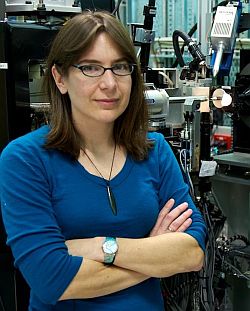Consumers can look forward to better and cheaper solar panels and future LCD screens, thanks to the recent discovery of a new type of liquid crystal. The discovery draws on results from the Australian Synchrotron.
Dr David Jones from the University of Melbourne and the Bio21 Institute, who made the discovery as part of an international research collaboration, said the new liquid crystal material would vastly improve the performance of printable organic solar cells.
The research team, which included Dr Rachel Williamson from the Australian Synchrotron, used the Synchrotron to investigate the fine details of the structure of the new liquid crystal material, an organic molecule known as BTR (benzodithiophene terthiophene rhodanine).
 Rachel Williamson from the Australian Synchrotron is helping to develop better solar panels.
Rachel Williamson from the Australian Synchrotron is helping to develop better solar panels.
In BTR liquid crystals, the molecules line up to point in the same direction but are not otherwise in a regular structure. This ‘nematic’ property means that BTR is very good at transporting charges –exactly what’s required for better conversion of light to electricity in a solar cell.
Another consequence of BTR’s ability to transport charges is that BTR liquid crystals can be printed in thicker films. This makes them more robust and easier to manufacture than other printable organic semiconductors. Potential applications could eventually include the development of higher-performing LCD screens and other new materials for consumer electronic devices.
The research, which was published in Nature Communications in January 2015, involved scientists in Australia, Singapore, China and Germany.
Media release from the University of Melbourne
